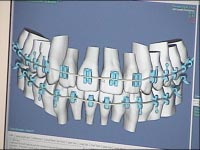Robotics in Orthodontics
 High-powered computers and advanced robotics continue to move forward in the field of orthodontics. An example of one of the new companies entering this field is SureSmile. They offer a system which combines three-dimensional computer imaging, exotic alloys and robotics. The company is claiming to reduce orthodontic treatment time, not move teeth any faster, but by moving teeth more efficiently. The technology is new and there is little research to validate their claim so far. Dr. Newhart is part of national study club that is working with the technology to test its uses, advantages and limitations. The technology is currently more expensive than conventional orthodontic because the
technology is new.
High-powered computers and advanced robotics continue to move forward in the field of orthodontics. An example of one of the new companies entering this field is SureSmile. They offer a system which combines three-dimensional computer imaging, exotic alloys and robotics. The company is claiming to reduce orthodontic treatment time, not move teeth any faster, but by moving teeth more efficiently. The technology is new and there is little research to validate their claim so far. Dr. Newhart is part of national study club that is working with the technology to test its uses, advantages and limitations. The technology is currently more expensive than conventional orthodontic because the
technology is new.
 The procedure starts with a scanning of the teeth. This can be accomplished by a cone beam scanner or by handheld scanner. The 3D image information is fed to a computer for further refinement.
The location and tension needed for the brackets and wire is fed into the computer by Dr. Newhart and the information is sent by Internet to the Sure Smile facility.
The procedure starts with a scanning of the teeth. This can be accomplished by a cone beam scanner or by handheld scanner. The 3D image information is fed to a computer for further refinement.
The location and tension needed for the brackets and wire is fed into the computer by Dr. Newhart and the information is sent by Internet to the Sure Smile facility.
 Now the robots come in. The orthodontic wire is gripped by two robotic pincers, which heats and bends the wire into a pattern that will guide the teeth into their preferred position. The wire, similar to Dr. Newhart’s proprietary Time-Release™ archwire, remembers its shape and is stiff when it is warm, but is highly flexible when cool – properties that are the reverse of most metals.
Now the robots come in. The orthodontic wire is gripped by two robotic pincers, which heats and bends the wire into a pattern that will guide the teeth into their preferred position. The wire, similar to Dr. Newhart’s proprietary Time-Release™ archwire, remembers its shape and is stiff when it is warm, but is highly flexible when cool – properties that are the reverse of most metals.
Even if the wire is purposely bent out of proper shape, once it is put in warm water, it springs back into its predetermined form and is ready to use. In the mouth, natural body heat keeps the wire firm and supplies tension to move the teeth.



